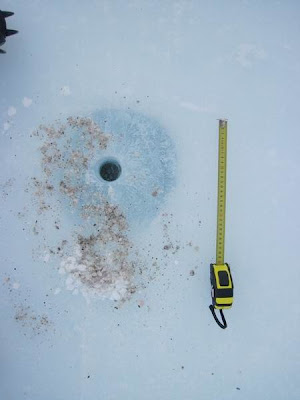It is sunny, with a moderate wind. In the morning, we decided to go first to the ridge and to check the fluorometer in field conditions. Our plans for the afternoon, is to go to the cryoconite field and try to open some of them. After 16.00, we will need to go and read the data from the temperature and humidity loggers. In addition, we need to develop a system that will allow to mark a selected area of biofilm for measurement with the fluorometer.
Why do we want to use this hand-held fluorometer? It can measure the chlorophyll fluorescence (OJIP) and thus, the ‘in vivo’ photosynthetic activity. As we are interested in photosynthetic organisms (cyanobacteria, algae, mosses, lichens), we can measure how efficient is their photosynthesis and understand whether they are stressed or happy under their Antarctic life conditions. This kind of apparatus is used, for example, in agriculture, to know if plants in the fields are stressed.

We have insulated the fluorometer but still, the battery runs out very quickly. I have to put it after each OJIP measurement under my jacket to warm the battery a little. Also, it would be better if this fluorometer would have the buttons and display on the upper side, because now it is not convenient to work with it. Results of fluorescence measurements were quite bad. Thanks to earlier measurements, I know that the apparatus works well. Thus, probably, the reason of the weak signal is due to the low temperature during measurements. The conditions are likely more extreme for the fluorometer than for the organisms! We will try in warmer conditions.
After lunch, we went to the blue ice field behind the Utsteinen nunatak (approxim 1 km from station). There were 4 cryoconite fields, mostly located within 100-200 m from slopes or moraine. We had a usual manual drill (4.5 cm diameter, 1 m length). There were cryoconites up to 5 m in diameter .

We didn’t drill the biggest but 4 of the small ones. Still, it was a lot of work. The thickness of a lid is between 2 cm and 20 cm. The ice lids had a lot of cracks and in one big cryoconites, we could clearly see bubbles inside.

The thickness of the liquid water phase was about 1-2 cm, the sediments were mostly composed by a big sandy grains about 3-4 mm diameter.
In the biggest opened cryoconite (60 to 30 cm size and 2 cm lid), there were patches of biofilms on the sand. The thickness of biofilms was up to 0,5 cm. Microscopy - dominated by the cyanobacterium Phormidium sp.
It seems that these cryoconites were formed once and long time ago, because we havn't seen any modern cryoconites without lid and the temperature was -3 C.
The surface of the blue ice field was clear, there was no deposition of sand coming from the nunatak. Nearby located cryoconites were connected to each other. When we drilled the lower located cryoconite after the upper one, the water was going out from the lower and decreased in the upper hole.
On the way back, I have checked the Southern shelter. There were 2 cm of snow on Alexander’s box in the corner, but in general everything was OK.

At about 17.30, we went again to the ridge to read the data from the microsensors. I was curious: will the OTC have a big effect on the temperature and humidity of the rock surface, compared to the control conditions? I took the Toughbook computer where the reading programme is installed to see how it works if the whole installation is put in environmental conditions. It works well but the problem was the low light intensity of the screen. It was still possible to work anyway. Major results: the OTC increases the temperature up to 10 C compared to the control (10 and 0 C) during the day. However, during the night, the surface temperature goes down to -11 C. So, it means that direct sunlight is necessary to increase the surface temperature. More information can be obtained from my diagrams, but I don't have any time to work on it.
We have also worked on the marking of biofilms without disturbing them. This is necessary because we want to make multiple measurements at different times, of the same part of the biofilms or living communities. We have installed several systems to mark a biofilm sampling position on the ridge, to compare them. There might be problems with snow deposition etc.
Today, electricity was installed in the 2 dry labs. They are 2 six meter containers with a lot of equipment. If I had known about it, we could have done better plans for the expedition. It's calm here and I work with my notebook here. The atmosphere in the station is too much ‘office like’. From the lab container, I can see Pingvinane and the people going for supper to the kitchen tent.
The sentence of the day is the exclamation "I don't have this equipment in my lab", each of us is repeating it with some hint of jealousy. Let’s dream! We have decided with Elie that we need here a 454 sequencer, because the more classical Sanger sequencing is not for a 21th century station!
Major results of the day: the test of the fluorometer, the discovery of cryoconites with liquid water and cyanobacterial biofilms, the reading of temperature data from the loggers and the finding that the OTC increase strongly the temperature
.
In the evening, I have talked with my parents. They say that it has become much warmer in their city in Siberia (Ulan Ude), it is now -32 C instead of -38 C. Here, it is about -11 C in the night and it makes them laugh!
Cheers, Zorigto

Aucun commentaire:
Enregistrer un commentaire